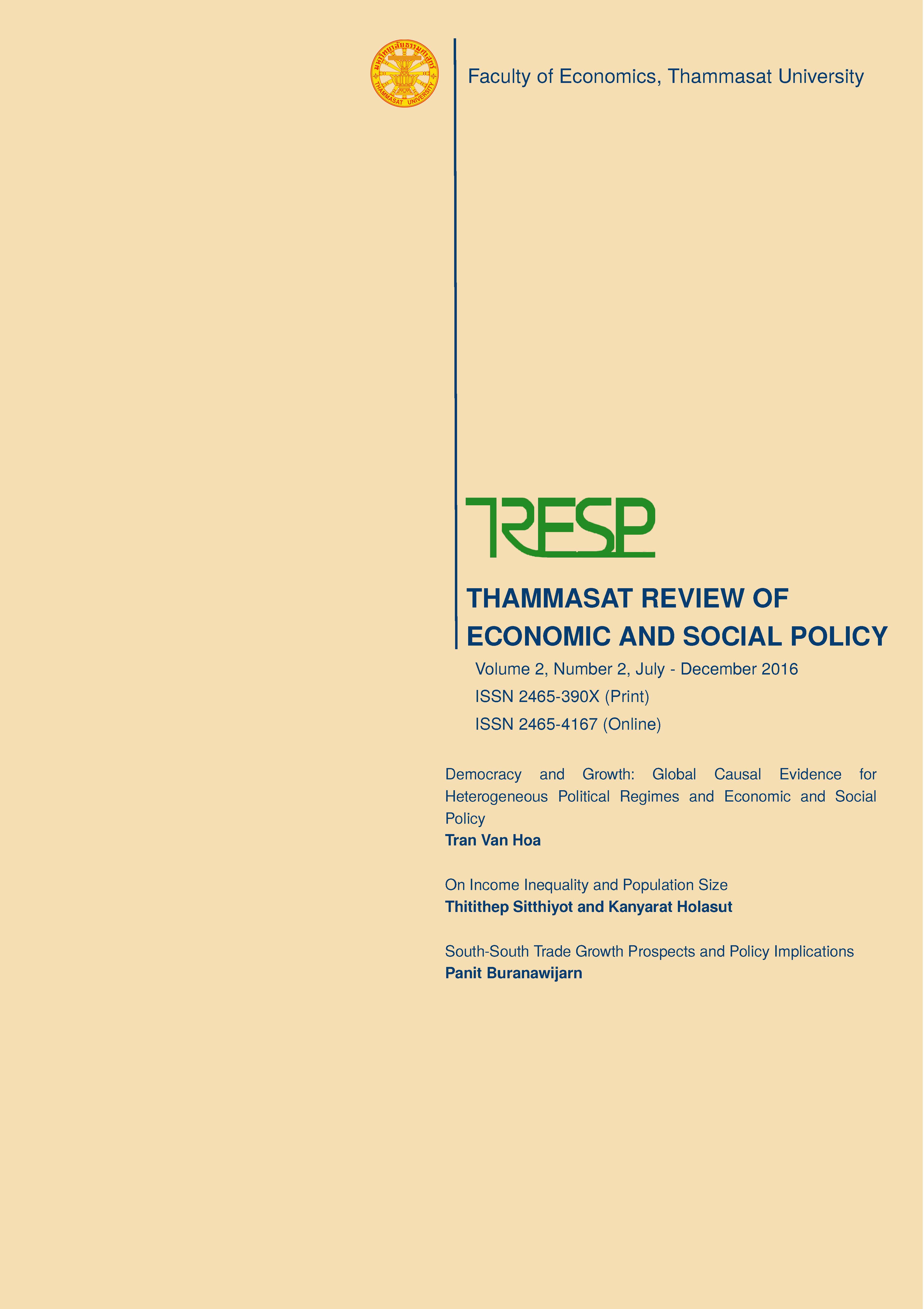Democracy and Growth: Global Causal Evidence for Heterogeneous Political Regimes and Economic and Social Policy
DOI:
https://doi.org/10.14456/tresp.2016.7Keywords:
Democracy and growth, Lipset/Aristotle and virtuous cycle, heterogeneous political regimes, simultaneous-equation modellingAbstract
The relationship between democracy and growth is of great importance to development of economic and social wellbeing policy but its directional causality is still generating lively debate conceptually and empirically. The paper introduces a simple simultaneous-equation model of democracy and growth for open economies and uses global data and system estimation to provide new evidence on democracy-growth causality and importantly the effects of different democratic institutions on it for strategic economic and social policy analysis. The findings confirm democracy causes growth globally but this causality is mixed for countries with heterogeneous political regimes. Regimespecific policy is therefore recommended for appropriate decision-making.
References
Acemoglu, D. (2010). Theory, General Equilibrium, and Political Economy in Development Economics. Journal of Economic Perspectives, Vol. 24, No. 3, pp. 17-32.
Acemoglu, D., Johnson, S., Robinson, J. A. and Yared, P. (2008). Income and Democracy. American Economic Review, Vol. 98, No. 3, pp. 808-42.
Acemoglu, D., Naidu. S., Restrepo, P., and Ronbinson. J. A. (2014). Democracy Does Cause growth, NBER Working Paper Series No. 20004. Retrieved from http://www.nber.org/papers/w20004 .
Azman-Saini, W.N.W., Baharumshah, A.Z. and Law, S.H. (2010). Foreign Direct Investment, economic Freedom and Economic Growth: International Evidence. Economic Modelling, Vol. 27, pp. 1079-1089.
Barro R. J. (1996). Democracy and Growth. Journal of Economic Growth, Vol. 1, pp. 1-27.
Bazzi, S and Clemens, M A. (2013). Blunt Instruments: Avoiding Common Pitfalls In Identifying the Causes of Economic Growth. American Economic Journal: Macroeconomics, Vol. 5, No. 2, pp. 152-186.
Dahl, R. A. (1970). Polyarchy. New Haven: Yale University Press.
Diamond, L. (2008, March-April). “The Democratic Rollback”. Foreign Affairs. Retrieved from https://www.foreignaffairs.com/articles/2008-03-02/democratic-rollback
Economist Intelligence Unit (2008). “Index of Democracy”. Retrieved from http://graphics.eiu.com/PDF/Democracy%20Index%202008.pdf
Economist Intelligence Unit (2015). “Democracy Index”. Retrieved from http://www.yabiladi.com/img/content/EIU-DemocracyIndex-2015.pdf
Jaunky, V. C. (2013). Democracy and Economic Growth in Sub-Saharan Africa: A Panel Data Approach, Empirical Economics, Vol. 45, pp. 987-1008.
Jochmann, M. and Koop, G. (2014). Regime-switching Cointegration. Studies in Nonlinear Dynamics and Econometrics, Vol. 19, No. 1.
Johnston, J. and DiNardo, J. (1997). Econometric Methods, 4 th Ed, New York: McGraw-Hill.
Murray, M. P. (2006). Avoiding Invalid Instruments and Coping with Weak Instruments. Journal of Economic Perspectives, Vol. 20, No. 4, pp. 111-132.
Narayan, P. K., Narayan, S. and Smyth, R. (2011). Does Democracy Facilitate Economic Growth or Does Economic Growth Facilitate Democracy? An Empirical Study of Sub-Saharan Africa. Economic Modelling, Vol. 28, pp. 900-910.
Persson, T. and Tabellini, G. (2007). The Growth Effect of Democracy: Is It Heterogeneous and How Can It Be Estimated?, NBER Working Paper Series No.13150. Retrieved from http://www.nber.org/papers/w13150
Rigobon, R. and Rodrik, D. (2005). Rule of Laws, Democracy, Openness and Income: Estimating Interrelationships. Economics of Transition, Vol. 13, No. 3, pp. 533-564.
Wooldridge, J. M. (2009). On Estimating Firm-level Production Functions using Proxy Variable Control for Unobservables. Economics Letters, Vol. 104, No. 3, pp. 112–114.



